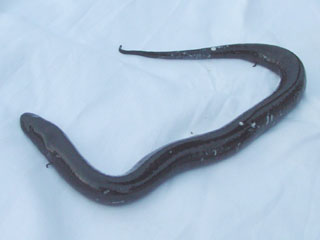Pythons and boas bear small spurs, used by males during courtship, near the cloaca (please see photo). These vestigial legs provide us with evidence that snakes may once have walked about on 4 limbs, but until recently we could only speculate as to further details. However, new technology has now enabled us to fill in some of the blanks, and may offer insights into other creatures that seem to be “losing their legs”, such as Worm Lizards and Sirens.
Snake Ancestors
Utilizing a developing technology known as Synchrotron-Radiation Computed Laminography, researchers at the Paris Museum of Natural History were able to microscopically examine snake fossils in new detail. They concluded that swimming or burrowing lizards were the most likely ancestors of modern-day snakes.
A Loss Becomes a Gain
Several large, aquatic salamanders native to the USA also seem to be evolving towards legless forms. Sirens, Siren spp. have front legs only while the huge Amphiumas, Amphiuma spp. have 4 tiny limbs (please see photo) that seem to be of little use.
Unencumbered by bulky limbs, streamlined serpents are able to follow rodents and other prey into tight burrows, find secure hiding spots and swim with ease. This allows them to exploit foods and habitats that were unavailable to competitors such as carnivorous lizards, mammals and fishes.
As the eons went by, snakes developed other adaptations, such as venom and unique constricting abilities, that enabled them to become effective predators despite being legless. Having observed snakes overcome large deer, caimans and other formidable animals, I can attest that they are in no way “disadvantaged”.
Evolution in Action Today?
Fossils of ancient snakes reveal that some had small front legs but lacked rear limbs…evidence, perhaps, of an intermediate stage in the process of leg loss. Interestingly, we can see many examples of “evolution in progress” among today’s reptiles and amphibians.
 Particularly fascinating is the suborder Amphisbaenia. Commonly known as Worm Lizards (please see photo), these little-studied creatures are distinct from true lizards. Most, such as the sole species found in Florida, are legless. However, Mexico’s Ajolotes, or Mole Lizards (Bipes spp.), lack rear limbs but have 2 stubby front legs that are used in mole-like fashion when digging. (please see the article below for a photo of these other-worldly little beasts).
Particularly fascinating is the suborder Amphisbaenia. Commonly known as Worm Lizards (please see photo), these little-studied creatures are distinct from true lizards. Most, such as the sole species found in Florida, are legless. However, Mexico’s Ajolotes, or Mole Lizards (Bipes spp.), lack rear limbs but have 2 stubby front legs that are used in mole-like fashion when digging. (please see the article below for a photo of these other-worldly little beasts).
A number of truly legless lizards, such as the Sheltopusik, Pseudopus apodus, and others that rely little upon their limbs, such as the Sandfish, Scincus scincus, are also known.
Further Reading
The Mexican Mole Lizard: great photos
Snake Evolution (National Geographic article)
Spurs image referenced from wikipedia and originally posted by Dawson
Amphisbaena alba image referenced from wikipedia and originally posted by Diogo B Provete
 That Reptile Blog – Reptile, Amphibian and Exotic Pet Care and Information
That Reptile Blog – Reptile, Amphibian and Exotic Pet Care and Information



Can a Legless Lizard cohabitat in the same aquarium as a hermit crab?
Hello,
No, it would not work out. The lizard would try to consume the crabs…even if unable to, the situation would be stressful for both. Also, each requires a different habitat. Please see these articles on Hermit Crab Care and Legless Lizard Care and please be in touch if you need more info. Enjoy, Frank